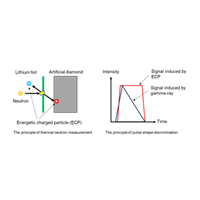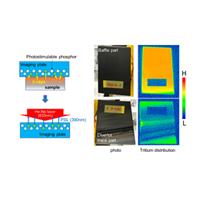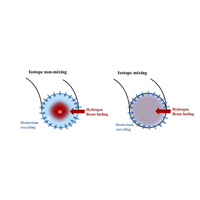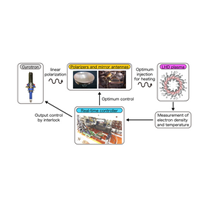Research Report2020

Slowing-down mechanism of rotating fluctuation in magnetic confinement plasmas
In the magnetic confinement plasmas of the Large Helical Device (LHD), a rotating fluctuation is often observed and its frequency sometimes decreases to almost zero. ...

Impurity accumulation layer profiles in the Large Helical Device have been successfully reproduced by simulation
In the Large Helical Device (LHD), for every plasma discharge, impurity layers have accumulated on the in-vessel-components. The layers are very fragile and are characterized by an exfoliation property. ...

Remaining tritium in graphite divertor tiles were quantitatively analyzed by using a full-combustion method
To reveal the triton transport and the tritium migration in a deuterium plasma experiment in LHD, remaining tritium in divertor tiles made of graphite was investigated by using a combustion method. ...

Discovering Turbulence to Help Plasma Mixing
The mixing state of hydrogen and deuterium in plasma was measured for the first time in the world in a mixed plasma experiment using hydrogen and deuterium in a large helical device (LHD). ...

World's First Detection of Anisotropy in Electron Motion by Spectroscopic Measurement
In the Large Helical Device (LHD), the polarization of light emitted by hydrogen atoms has been measured with an accuracy of 1%. ...

Neutron measurement using an artificial diamond
We established a pulse shape discrimination method for evaluating thermal neutron flux using an artificial diamond detector. ...

Let the accumulated data talk about the state of plasma
We have developed a method for grasping the state of plasma using a large amount of data accumulated in experiments in the Large Helical Device (LHD) and have succeeded in demonstrating its practicality. ...

Investigating the cause of the disturbance in maintaining the high-ion temperature state
The Large Helical Device (LHD) has achieved ion temperatures above 120 million degrees Celsius. In high-ion temperature plasma discharges, magnetic field oscillations, generated by the pressure of the energetic ions, occur frequently. ...

Lose weight of fusion reactor component
The group of associate professor Hitoshi Tamura and others of the National Institute of Natural Sciences (NINS) National Institute for Fusion Science (NIFS) first applied topology optimization technique to the concept design of a helical fusion reactor which aims to demonstrate power generation. ...

An accurate simulation of high-pressure plasma for an economical helical fusion reactor
The research team of Assistant Professor Masahiko Sato and Professor Yasushi Todo of the National Institutes of Natural Sciences (NINS) National Institute for Fusion Science (NIFS) has succeeded using computer simulation in reproducing the high-pressure plasma confinement observed in the Large Helical Device (LHD). ...

Estimation of the beam ion confinement time in LHD
The confinement time of fast ions, which are generated by the neutral beam injection, has been estimated quantitatively in the LHD deuterium experiment by using neutron measurement and integrated simulation. ...

First observation of tritium distribution on plasma facing surfaces in stellarator/heliotron devices
Tritium distribution on plasma facing surfaces after the first deuterium plasma experimental campaign, conducted over four months, was investigated in the Large Helical Device (LHD) for the first time in stellarator/heliotron devices by using the tritium imaging plate technique. ...

Isotope movement holds key to the power of fusion reactions
Fusion may be the future of clean energy. The same way the sun forces reactions between light elements, such as hydrogen, to produce heavy elements and heat energy, fusion on Earth can generate electricity by harnessing the power of elemental reactions. ...

Mechanism of plasma radiation concentration at “knot”of magnetic field lines
It has been reproduced in the newly developed simulation code that plasma radiation concentrates at the “knot” of the magnetic field lines, and its mechanism is recognized as the same as thermal condensation instability, which also occurs at star formation in the universe. ...

Real-time control of millimeter-wave propagation for highly efficient plasma heating
We have developed a real-time control system for the millimeter-wave injection system for electron cyclotron heating and have shown that the system can heat the plasma efficiently by optimizing the injection for the time-varying plasma in the Large Helical Device (LHD)....

Ion measurement by millimeter and sub-millimeter in plasma
In high-temperature plasmas, it is not easy to diagnose the state of ions and fast ions because they cannot be measured directly by a thermometer. ...
